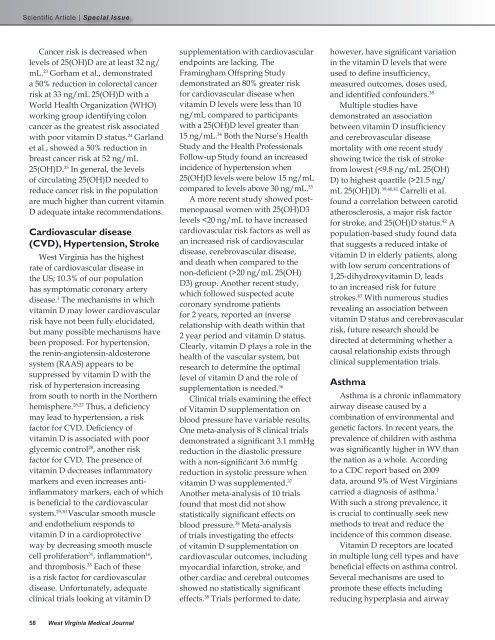Special CME Issue - West Virginia State Medical Association
Special CME Issue - West Virginia State Medical Association
Special CME Issue - West Virginia State Medical Association
You also want an ePaper? Increase the reach of your titles
YUMPU automatically turns print PDFs into web optimized ePapers that Google loves.
Cancer risk is decreased when<br />
levels of 25(OH)D are at least 32 ng/<br />
mL. 23 Gorham et al., demonstrated<br />
a 50% reduction in colorectal cancer<br />
risk at 33 ng/mL 25(OH)D with a<br />
World Health Organization (WHO)<br />
working group identifying colon<br />
cancer as the greatest risk associated<br />
with poor vitamin D status. 24 Garland<br />
et al., showed a 50% reduction in<br />
breast cancer risk at 52 ng/mL<br />
25(OH)D. 25 In general, the levels<br />
of circulating 25(OH)D needed to<br />
reduce cancer risk in the population<br />
are much higher than current vitamin<br />
D adequate intake recommendations.<br />
Cardiovascular disease<br />
(CVD), Hypertension, Stroke<br />
<strong>West</strong> <strong>Virginia</strong> has the highest<br />
rate of cardiovascular disease in<br />
the US; 10.3% of our population<br />
has symptomatic coronary artery<br />
disease. 1 The mechanisms in which<br />
vitamin D may lower cardiovascular<br />
risk have not been fully elucidated,<br />
but many possible mechanisms have<br />
been proposed. For hypertension,<br />
the renin-angiotensin-aldosterone<br />
system (RAAS) appears to be<br />
suppressed by vitamin D with the<br />
risk of hypertension increasing<br />
from south to north in the Northern<br />
hemisphere. 26,27 Thus, a deficiency<br />
may lead to hypertension, a risk<br />
factor for CVD. Deficiency of<br />
vitamin D is associated with poor<br />
glycemic control 28 , another risk<br />
factor for CVD. The presence of<br />
vitamin D decreases inflammatory<br />
markers and even increases antiinflammatory<br />
markers, each of which<br />
is beneficial to the cardiovascular<br />
system. 29,30 Vascular smooth muscle<br />
and endothelium responds to<br />
vitamin D in a cardioprotective<br />
way by decreasing smooth muscle<br />
cell proliferation 31 , inflammation 16 ,<br />
and thrombosis. 33 Each of these<br />
is a risk factor for cardiovascular<br />
disease. Unfortunately, adequate<br />
clinical trials looking at vitamin D<br />
supplementation with cardiovascular<br />
endpoints are lacking. The<br />
Framingham Offspring Study<br />
demonstrated an 80% greater risk<br />
for cardiovascular disease when<br />
vitamin D levels were less than 10<br />
ng/mL compared to participants<br />
with a 25(OH)D level greater than<br />
15 ng/mL. 34 Both the Nurse’s Health<br />
Study and the Health Professionals<br />
Follow-up Study found an increased<br />
incidence of hypertension when<br />
25(OH)D levels were below 15 ng/mL<br />
compared to levels above 30 ng/mL. 35<br />
A more recent study showed postmenopausal<br />
women with 25(OH)D3<br />
levels 20 ng/mL 25(OH)<br />
D3) group. Another recent study,<br />
which followed suspected acute<br />
coronary syndrome patients<br />
for 2 years, reported an inverse<br />
relationship with death within that<br />
2 year period and vitamin D status.<br />
Clearly, vitamin D plays a role in the<br />
health of the vascular system, but<br />
research to determine the optimal<br />
level of vitamin D and the role of<br />
supplementation is needed. 36<br />
Clinical trials examining the effect<br />
of Vitamin D supplementation on<br />
blood pressure have variable results.<br />
One meta-analysis of 8 clinical trials<br />
demonstrated a significant 3.1 mmHg<br />
reduction in the diastolic pressure<br />
with a non-significant 3.6 mmHg<br />
reduction in systolic pressure when<br />
vitamin D was supplemented. 37<br />
Another meta-analysis of 10 trials<br />
found that most did not show<br />
statistically significant effects on<br />
blood pressure. 38 Meta-analysis<br />
of trials investigating the effects<br />
of vitamin D supplementation on<br />
cardiovascular outcomes, including<br />
myocardial infarction, stroke, and<br />
other cardiac and cerebral outcomes<br />
showed no statistically significant<br />
effects. 38 Trials performed to date,<br />
however, have significant variation<br />
in the vitamin D levels that were<br />
used to define insufficiency,<br />
measured outcomes, doses used,<br />
and identified confounders. 38<br />
Multiple studies have<br />
demonstrated an association<br />
between vitamin D insufficiency<br />
and cerebrovascular disease<br />
mortality with one recent study<br />
showing twice the risk of stroke<br />
from lowest (21.5 ng/<br />
mL 25(OH)D). 39,40,41 Carrelli et al.<br />
found a correlation between carotid<br />
atherosclerosis, a major risk factor<br />
for stroke, and 25(OH)D status. 42 A<br />
population-based study found data<br />
that suggests a reduced intake of<br />
vitamin D in elderly patients, along<br />
with low serum concentrations of<br />
1,25-dihydroxyvitamin D, leads<br />
to an increased risk for future<br />
strokes. 43 With numerous studies<br />
revealing an association between<br />
vitamin D status and cerebrovascular<br />
risk, future research should be<br />
directed at determining whether a<br />
causal relationship exists through<br />
clinical supplementation trials.<br />
Asthma<br />
Asthma is a chronic inflammatory<br />
airway disease caused by a<br />
combination of environmental and<br />
genetic factors. In recent years, the<br />
prevalence of children with asthma<br />
was significantly higher in WV than<br />
the nation as a whole. According<br />
to a CDC report based on 2009<br />
data, around 9% of <strong>West</strong> <strong>Virginia</strong>ns<br />
carried a diagnosis of asthma. 1<br />
With such a strong prevalence, it<br />
is crucial to continually seek new<br />
methods to treat and reduce the<br />
incidence of this common disease.<br />
Vitamin D receptors are located<br />
in multiple lung cell types and have<br />
beneficial effects on asthma control.<br />
Several mechanisms are used to<br />
promote these effects including<br />
reducing hyperplasia and airway<br />
58 <strong>West</strong> <strong>Virginia</strong> <strong>Medical</strong> Journal















